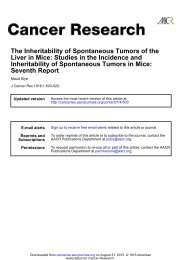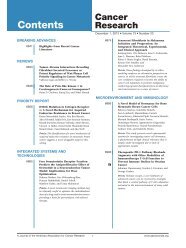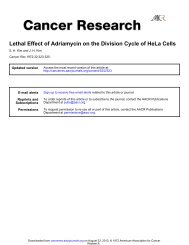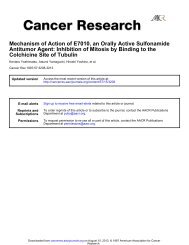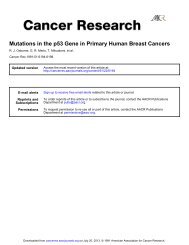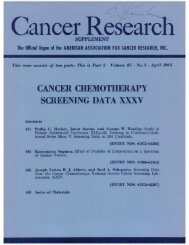XANTHOMA OF THE BREAST In a series of nine hundred (circa ...
XANTHOMA OF THE BREAST In a series of nine hundred (circa ...
XANTHOMA OF THE BREAST In a series of nine hundred (circa ...
You also want an ePaper? Increase the reach of your titles
YUMPU automatically turns print PDFs into web optimized ePapers that Google loves.
Downloaded from cancerres.aacrjournals.org on December 28, 2013. © 1932<br />
American Association for Cancer Research.<br />
1080 CUSHMAN D. HAAGENSEN<br />
family in which three sisters had xanthoma nodules <strong>of</strong> the hands<br />
and feet and hypercholesterinemia. Schmidt has described a<br />
family in which all five <strong>of</strong>fspring <strong>of</strong> a healthy father and mother<br />
were affected. At one time or another all the children showed<br />
hypercholesterinemia.<br />
(3) Xanthoma diabeticorum: These rare cases may present<br />
generalized xanthomas involving the skin, mucous membranes,<br />
serous surfaces, liver, spleen, and many other viscera. Lubarsch<br />
reported a case in which the xanthomatosis was particularly<br />
prominent in the liver, lymph nodes, gums, bone marrow, and<br />
appendix. He believes that, in addition to the underlying hypercholesterinemia,<br />
a condition <strong>of</strong> lymphoid stasis is concerned in<br />
xanthomatosis. <strong>In</strong> such lymphoid stasis he sees the explanation<br />
for xanthomatosis being most prominent in the organs containing<br />
lymphoid tissue, as in his case. At autopsy <strong>of</strong> a woman dying<br />
with diabetes Petri found a massive xanthoma <strong>of</strong> the mesentery.<br />
<strong>In</strong> an attempt to identify the particular lipoids contained in the<br />
tumor, many staining reactions and methods <strong>of</strong> chemical analysis<br />
for different lipoids were employed. The most significant finding<br />
was a total cholesterin content ten times that <strong>of</strong> normal mesenteric<br />
tissue.<br />
Major studied three cases <strong>of</strong> xanthoma diabeticorum which<br />
showed an elevated blood cholesterin. Following suitable diabetic<br />
treatment the blood cholesterin fell to within normal limits and<br />
some <strong>of</strong> the xanthoma nodules disappeared. Richter, Wile,<br />
Eckstein, and Curtis, and also Ralli have described similar cases in<br />
which the xanthoma nodules regressed when the patient was put<br />
on a diabetic regime. Ralli's case was particulary noteworthy in<br />
that the patient had a pituitary tumor and acromegaly associated<br />
with true diabetes mellitus.<br />
(4) Christian's-Schiiller's Disease: <strong>In</strong> 1916 Schuller described<br />
the cases <strong>of</strong> two children with defects in the skull and exophthalmos.<br />
The elder, a boy aged sixteen, also showed dystrophia adiposogenitalis,<br />
and the younger, a girl aged four, had diabetes insipidus.<br />
<strong>In</strong> 1919 Christian reported the case <strong>of</strong> a child aged five with defects<br />
in the membranous bones, exophthalmos, and diabetes insipidus.<br />
Occasional cases presenting the features <strong>of</strong> this peculiar syndrome<br />
continued to be reported without any light being thrown on the<br />
pathogenesis <strong>of</strong> the disease. Several cases were autopsied, and<br />
yellowish or brownish growths eroding the base <strong>of</strong> the skull and in<br />
other viscera were found; they were interpreted as inflammatory or



